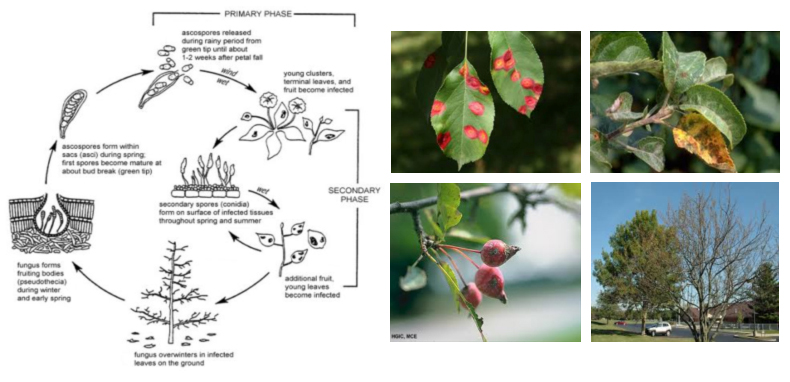Apple Scab occurs in most areas of the world where apples are grown, it is one of the most serious diseases of ornamental crabapple and fruit trees. The disease is caused by the fungus Venturia Inaequalis. Apple Scab occurs on the leaves, petioles, blossoms and fruit. Infections usually develop first on the undersides of leaves. Once the leaf has unfolded, both sides may be infected.

Symptoms appear as olive, to velvety brown spots, that turn black with age. At first the margins of lesions are feathery and indefinite, but later they become distinct. Severe infection can cause extensive defoliation. Fruit infections resemble leaf infections when young but become brown and corky with age. Scab infections result in uneven growth of fruit and cracking of the skin and flesh. Apple Scab rarely kills a tree, though repeated infections will weaken the tree and increase its susceptibility to other problems.
Apple Scab spores are produced on fallen leaves that were previously infected and on the tree itself during the growing season. The spores spread by wind and rain. The disease is most severe in years with cool, wet spring weather.
The Apple Scab fungus overwinters on fallen leaves. Infected leaves that are left under the tree are sources of disease for the following growing season. To help prevent recurrence of the disease next year, remove and destroy leaf debris and infected fruit in fall. Though it may be impossible to remove all of the leaves from your property, removal of the majority of fallen leaves will greatly decrease the amount of inoculum in the area.
Our Arborists at L.C.S Lawn and Tree Service, Inc. control Apple Scab with a fungicide spray. Like most fungal diseases, timing of the fungicide applications is important for control of the disease. The fungicide needs to be applied 3 times per year, with the first application performed at bud break, then following up 3-4 weeks later for each additional spray. Apple Scab can be prevented but once symptoms begin it can not be removed, you will only be able to prevent it from spreading further the following year.
